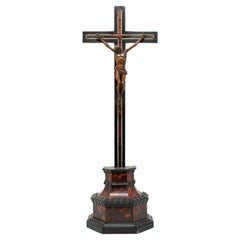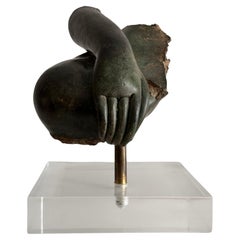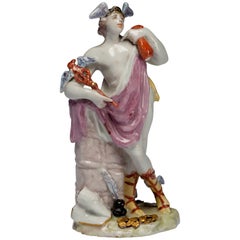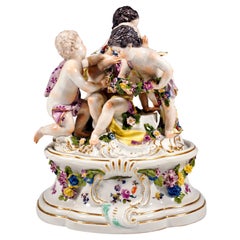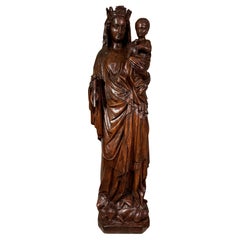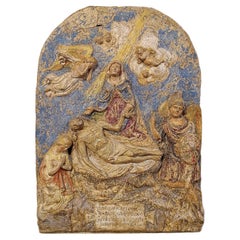18th Century and Earlier Figurative Sculptures
to
218
1,146
1,146
3,753
9,075
2,751
2,267
3,206
2,041
303
151
564
562
255
490
565
671
386
268
217
111
63
14
14
10
6
2
1
620
250
249
212
106
592
484
821
375
175
145
104
Height
to
Width
to
1,146
1,146
1,146
67
28
20
9
7
Period: 18th Century and Earlier
17th Century Cricifix Boxwood
Located in Milan, IT
17th century
Crucifix
Measures: Boxwood, 42 cm high x 8 x 14
The sculpture depicting the crucified Christ examined here represents a refined example of seventeenth-century cabinetry in boxwood. The figure of Christ, now dead on the cross, is part of a precious artistic choreography with the structure of the cross and its pedestal, both decorated with tortoiseshell mirrors, ivory threads to emphasize the structure of the cross and elements in ebonized and carved wood to highlight the architectural structure of the pedestal.
The departure of Christ is evident from the lowered head, from the open hands...
Category
Italian Antique 18th Century and Earlier Figurative Sculptures
Materials
Boxwood
A Thai Bronze, Buddha Fragment, 15th Century
Located in PARIS, FR
A Thai bronze, Buddha fragment, 15th century.
Arm, hand and leg fragment, mounted on a plexiglas stand from 70s.
Overall: 17,2 cm.
Category
Antique 18th Century and Earlier Figurative Sculptures
Materials
Bronze
Figure, Mercury, Bow Porcelain, circa 1748
Located in Melbourne, Victoria
He wears a winged helmet and sandals, a loosely draped pink, white, and yellow washed cloak over a short tunic, and leans arrogantly against bales, his message sack over his left sho...
Category
English Neoclassical Antique 18th Century and Earlier Figurative Sculptures
Materials
Porcelain
$8,400 Sale Price
30% Off
Early Meissen Cupid Group Around 1750, Allegory of Spring, with Additional Base
Located in Vienna, AT
Four scantily clad cupids grouped on a rock, partly flowers, partly holding flower arrangements in their hands, the flowers as a typical attribute of the Meissen spring representatio...
Category
German Rococo Antique 18th Century and Earlier Figurative Sculptures
Materials
Porcelain
A Very Large Virgin and Child ( 49 inches) , Champagne, circa 1500
Located in PARIS, FR
A Very Large Virgin and Child in walnut wood, carved in the round, trampling on Eve biting into the apple.
The theme of the Virgin and Child is the most represented in all Christian...
Category
French Renaissance Antique 18th Century and Earlier Figurative Sculptures
Materials
Walnut
MID-16th CENTURY RENAISSANCE POLYCHROME PLASTER
Located in Firenze, FI
Beautiful Renaissance polychrome plaster, with original painting, applied to a wooden panel. The plaster depicts the Deposition of Christ, clearly visible in the center, with the dyi...
Category
Italian Renaissance Antique 18th Century and Earlier Figurative Sculptures
Materials
Stucco, Paint
Figure: Running Girl, Bow Porcelain Factory, circa 1756
Located in Melbourne, Victoria
Small figure of a young woman wearing a puce-sprigged white skirt, lifted slightly with her left hand, pale pink jacket with typical Bow opaque blue collar and cuffs.
We've called...
Category
English Rococo Antique 18th Century and Earlier Figurative Sculptures
Materials
Porcelain
18th-19th Century Italian Wood Carved Angel
Located in San Francisco, CA
A lovely angel, his right hand extended as if to touch something or hold
something. He appears very calm and peaceful, clothed in a partial shroud
which is draped over his shoulder...
Category
Italian Baroque Antique 18th Century and Earlier Figurative Sculptures
Materials
Wood
Italian Limestone Venus Sculpture
Located in Dallas, TX
This Italian Limestone Venus Sculpture is a stunning depiction of the goddess of love, carved with incredible detail and from authentic 18th century limestone sourced from Italy. The...
Category
Antique 18th Century and Earlier Figurative Sculptures
Materials
Limestone
Important German Pietà from the, 14th Century
Located in Saint-Ouen, FR
IMPORTANT GERMAN PIETÀ FROM THE 14th CENTURY
ORIGIN: GERMANY, REGION DE COLOGNE
PERIOD: BEGINNING IF THE 14th CENTURY, ca. 1330
Height: 98 cm
Length: 45 cm
Depth: 33 cm
Polychromed linden wood
Good condition of conservation
Provenance : particular Alsatian collection
The theme of the Pietà or Vesperbild appears in Germany at the end of the 13th century, reflecting the mysticism of the late Middle Ages. Although the theme does not exist in the Gospels, it was often mentioned in contemporary devotional literature. Indeed, during the first half of the 14th century, mystical thought and devotional practices changed under the impulse of a number of religious, among them Heinrich Suso and St Bridget. In his writings, Suso placed important emphasis on contemplation and meditation in the footsteps of Christ's martyrdom.
This will have great impact in the field of art, especially in Germany and later in France. The emphasis will from now on be on grief, death is shown in a straightforward way. The wounds of Christ are gaping and bloody. The suffering of Christ and the seven sorrows of the Virgin Mary are meditated upon.
This piece demonstrates the interest of the faithful in these representations where pathos reigns.
The virgin is represented seated in a frontal position. The bust is very elongated. She is wearing a red dress with a simple neckline and a blue mantel...
Category
Antique 18th Century and Earlier Figurative Sculptures
Materials
Wood
Saint Michael the Archangel, polychrome carved wood, attributed to L.S. Carmona
Located in Madrid, España
A polychrome carved wooden statue of St. Michael the Archangel. It's believed to be the work of Luis Salvador Carmona (Nava del Rey, Valladolid, 15 November 1708 – Madrid, 4 Februar...
Category
Spanish Baroque Antique 18th Century and Earlier Figurative Sculptures
Materials
Wood
18th century Spanish santos figure ...
Located in Brecht, BE
a very elegant spanish polychromed wood santos figures with articulated hands ...
pure poetry ...
Category
Spanish Antique 18th Century and Earlier Figurative Sculptures
Materials
Softwood
Pair of 18th-century architectural fragments
Located in Rio De Janeiro, BR
This pair of 18th-century architectural fragments captures the elegance and craftsmanship of colonial-era decorative art. Originally part of a larger structure, these wooden fragments showcase intricate carvings, likely once embellishing a grand interior space with their distinctive style. Each piece features a graceful, fluted column-like design with scrolling volutes, adding a sense of movement and refinement that reflects the baroque influence prevalent during the period.
The patina on the wood speaks to the age and authenticity of these fragments, with a natural wear that enhances their character and historical charm. Delicate foliate motifs can be observed near the top, subtly incorporated into the design to evoke a sense of organic beauty. The unique curvature and details would have made these fragments a highlight within their original architectural setting.
These fragments are versatile in their potential uses today, making them ideal as decorative pieces in various settings. Whether mounted on a wall or displayed on pedestals, they serve as striking reminders of 18th-century artistry and add a sense of historical grandeur to any space. Perfect for collectors of architectural antiques or those seeking to bring a touch of old-world charm into their interiors, these fragments stand...
Category
Brazilian Baroque Antique 18th Century and Earlier Figurative Sculptures
Materials
Cedar
Pair of English Carved Walnut Wood Figures of Court Jesters, 18th Century
Located in North Miami, FL
A very fine pair of 18th century carved figures, of Court Jesters These bearded gentlemen have been superbly carved in the finest detail, they original came from a piece of early 18th Century Furniture...
Category
English Baroque Antique 18th Century and Earlier Figurative Sculptures
Materials
Wood, Walnut
Sculpted Clay Head of African Woman
Located in Dallas, TX
Sculpted clay head of a beautiful African woman. Light sandy brown with rough texture. A hand sculpted piece. Head adorned with a decorative circular pattern...
Category
Antique 18th Century and Earlier Figurative Sculptures
Materials
Clay
Unusual Tang Dynasty Persian Horse Rider Statue, Silk Road Trader, TL Tested
Located in Greenwich, CT
A fine and unusual statue of standing horse with a Persian rider. Tang Dynasty (618-907 AD) Silk Road trader from Persia, comes with Oxford authenticati...
Category
Chinese Tang Antique 18th Century and Earlier Figurative Sculptures
Materials
Terracotta
$6,200 Sale Price
20% Off
Virgin and Child in Majesty, also known as "Sedes Sapientae"
Located in Saint-Ouen, FR
VIRGIN AND CHILD IN MAJESTY, ALSO KNOWN AS "SEDES SAPIENTIAE"
ORIGIN : SPAIN, CATALOGNE
PERIOD: EARLY 13th CENTURY
Height : 95 cm
Width : 32 cm
Depth : 28 cm
Softwood
No polychromy
In the middle of the 12th century, the Virgin took her place in churches, seated in Majesty, serving as a throne for her son Jesus. She is then called Sedes Sapientiae, meaning the Throne of Wisdom.
At that time, she is not represented for herself and only exists because she has been designated as Theotokos, the mother of God, at the Council of Ephesus in 431, where the divine nature of Christ was proclaimed from his birth.
The upright and perfectly hieratic bust of this Virgin and Child in Majesty is seated on a throne-bench. She is dressed in a tunic with a rounded neckline and covered with a fine mantle placed on her narrow shoulders. The supple and natural drapery follows the lines of the body.
Large curls frame her face with delicate and regular features, a long straight nose, almond-shaped eyes, and small lips.
She supports the Infant Jesus with her left hand. Like his mother, he is dressed in a long tunic, and his little feet are visible in the folds. He holds a small sphere in his left hand, while with his right hand, he gestures in blessing. The face of Christ bears a strong resemblance to his mother’s one, and he gives a slight smile.
The position of the Child is no longer as hieratic, nor frontal or central as in the early 12th century, but his face still turns towards the faithful.
The 13th century indeed emerges as a period of transition in the artistic domain. The statuary, while retaining certain characteristics still belonging to the habits of the previous century, also develops new formal solutions.
As a result, Mary maintains a hieratic and frontal position, while her son shifts to place himself well to the left on her knee. Similarly, while the Virgin seems perfectly still, Jesus, on the other hand, appears much more animated, especially in the positioning of his hands. His left hand holds the orb, and judging by the raised right arm directed towards the faithful, one can easily imagine that he was making a gesture of blessing.
The influence of the Sedes Sapientiae from previous centuries still seems particularly prevalent in this work.
These few characteristics allow dating this Spanish Virgin...
Category
Spanish Gothic Antique 18th Century and Earlier Figurative Sculptures
Materials
Softwood
Pair of Oak Ceroferarius Angels , Flanders , 17th Century
Located in PARIS, FR
Beautiful pair of cerulean angels sculpted in the round in a very lively position (the movement in the hair is remarkable), almost baroque.
Very nice execution of the armour in the ...
Category
Belgian Baroque Antique 18th Century and Earlier Figurative Sculptures
Materials
Oak
Pair of Chinese Blue Glazed Chiwen Roof Tiles, c. 1750
Located in Chicago, IL
These monumental Chinese roof tiles were once installed as part of the elaborate roof of an early Qing-dynasty temple or grand courtyard home. Dated to the 18th century, the sculptur...
Category
Chinese Qing Antique 18th Century and Earlier Figurative Sculptures
Materials
Earthenware
18th Century Marble Bust of a Young Woman
Located in Millbrook, NY
Stunning 18th Century marble bust of a young woman. This hand carved head has so much presence. There are so many details that make this stunning. Starting with the tendrils of her ...
Category
Neoclassical Antique 18th Century and Earlier Figurative Sculptures
Materials
Marble
Japanese Haniwa Terracotta Head of a Warrior
Located in Hudson, NY
Japanese Haniwa terracotta head of a warrior, Haniwa figures are Japanese terracotta funerary figures that accompanied the dead buried in early Japan, ...
Category
Japanese Antique 18th Century and Earlier Figurative Sculptures
Materials
Terracotta
Han Dynasty Pottery Kneeling Court Attendant Figure
Located in Dallas, TX
Chinese painted pottery kneeling court attendant. A solemn downward looking tomb minqui attendant cold painted kneeling on wooden stand. Hands were originally wood and never last due...
Category
Chinese Han Antique 18th Century and Earlier Figurative Sculptures
Materials
Pottery
17th Century Italian Carving of Scholar
Located in Los Angeles, CA
Originally gilded. as notice some traces of gilt residue. From the collection of Verna Harrah. Harra's Casinos.
Category
Italian Neoclassical Antique 18th Century and Earlier Figurative Sculptures
Materials
Wood
Jean Boulogne Bronze Sculpture
Located in Los Angeles, CA
Jean Boulogne bronze sculpture "Abduction of the Sabine Women" a verdigris patinated bronze figured group on a circular stylized. Base signe "Jean Bologne".
Category
Italian Antique 18th Century and Earlier Figurative Sculptures
Materials
Bronze
Italian 17th Century Patinated Wood Carved Statue
Located in West Palm Beach, FL
A wonderful and charming Italian 17th century patinated wood carved statue of an angel. The captivating angel is raised by a circular base and dress...
Category
Italian Antique 18th Century and Earlier Figurative Sculptures
Materials
Wood
Beautiful German Pieta known as "Vesperbild"
Located in Saint-Ouen, FR
BEAUTIFUL GERMAN PIETA KNOWN AS “VESPERBILD”
ORIGIN : GERMANY
PERIOD : 15th CENTURUY
Height : 74 cm
Width : 43 cm
Depth : 22,5 cm
Good condition
Oak wood
This beautiful 15th-c...
Category
German Gothic Antique 18th Century and Earlier Figurative Sculptures
Materials
Oak
Early Japanese Hinoki Wood Sculpture of Bishamon
Located in Hudson, NY
Early Japanese Hinoki wood sculpture of Bishamon. Kamakura period (1185 - 1333) sculpture made from hinoki wood. Bishamon is also known as Tamonten, meanin...
Category
Japanese Antique 18th Century and Earlier Figurative Sculptures
Materials
Wood
Large Sculptural 18th Century Italian Figure of Christ on Calcite Crystal Matrix
By Interi
Located in Dublin, Dalkey
Large 18th century Italian figure of Christ adorned with calcite and resting on a calcite crystal cluster in matrix. The figure of Christ was originally part of a crucifix from a chu...
Category
Italian Rococo Antique 18th Century and Earlier Figurative Sculptures
Materials
Crystal, Rock Crystal, Gold Leaf
18th Century Baroque Giltwood Putto – Hand-Carved & Painted Antique Cherub
Located in Lincoln, GB
18th Century Baroque Giltwood Putto – Hand-Carved & Painted Antique Cherub
This remarkable 18th century Baroque giltwood putto is a fine example of ecclesiastical art from the late ...
Category
Antique 18th Century and Earlier Figurative Sculptures
Materials
Wood
Pair of Ming Dynasty Horsemen Roof Tiles
Located in London, GB
A pair of Chinese Ming Dynasty (1368-1644) sancai-glazed ridge tiles modelled as horse and rider. Both tiles are glazed in rich green and amber, the horses ...
Category
Chinese Ming Antique 18th Century and Earlier Figurative Sculptures
Materials
Pottery
French Limestone Saint Sculpture
Located in Dallas, TX
This 17th century French Limestone Saint Sculpture demonstrates remarkable artistry, skilfully sculpted from French Limestone to ensure its aesthetic ...
Category
Antique 18th Century and Earlier Figurative Sculptures
Materials
Limestone
CHILD JESUS SAVIOR OF THE WORLD 18th Century
Located in Madrid, ES
CHILD JESUS SAVIOR OF THE WORLD 18th Century
portuguese sculpture
in polychrome and gilded wood with fabric cover. Mounted on a spherical base and golden plinth. Shine in silver, un...
Category
Portuguese Baroque Antique 18th Century and Earlier Figurative Sculptures
Materials
Wood
$1,808 Sale Price
20% Off
Chinese Ming Dynasty Terracotta Court Official Statuette, Original Polychromy
Located in Yonkers, NY
A petite Chinese Ming dynasty green glazed terracotta court official figurine from the 15th or 16th century, with original polychromy. Attracting our eye with its vibrant polychromy,...
Category
Chinese Ming Antique 18th Century and Earlier Figurative Sculptures
Materials
Terracotta
Grand Tour Sphinx
Located in Dallas, TX
A late 18th century grand tour era Egyptian marble sphinx. Sphinx is sitting on attached black marble base.
Category
Egyptian Antique 18th Century and Earlier Figurative Sculptures
Materials
Marble
$2,750
Set of Three 18th Century Italian Gold Flower Fragments with Aurora and Calcite
By Interi
Located in Dublin, Dalkey
Set of three 18th century Italian gold leaf hand-carved wood flower fragments adorned with aurora quartz and each mounted on a calcite optical base. The fragments originally came fro...
Category
Italian Rococo Antique 18th Century and Earlier Figurative Sculptures
Materials
Agate, Gold Leaf
Gothic Virgin and Child from Flanders
Located in Saint-Ouen, FR
Exhibition
Museum Cantini, 1952, The art of the Middle Ages in the Marseille collections, n°101
Provenance
Former collection Louis Bresset (before 1952)
Former collection Profe...
Category
Dutch Gothic Antique 18th Century and Earlier Figurative Sculptures
Materials
Oak
Early 17th Century Carved Wood Figure of Guanyin
Located in Gloucestershire, GB
17th Century carved figure of Guanyin in Rajalalitasana position.
Seated on rock with the right arm rested on the right knee. The figures are wearing loose robes that open at the ch...
Category
Chinese Antique 18th Century and Earlier Figurative Sculptures
Materials
Wood
Large Terracotta Relief - Lombardy, First Half of 17th Century
Located in Bruxelles, BE
Large Terracotta relief of the flight into Egypt
Lombardy, first half of 17th century
Painted terracotta
91 x 85 x 11,5 cm
This event in the early life of Christ is recounted i...
Category
Italian Baroque Antique 18th Century and Earlier Figurative Sculptures
Materials
Terracotta
$61,979 Sale Price
20% Off
Late 18th / Early 19th Century Italian Giltwood Neoclassical Angel
Located in Buisson, FR
Wonderful and very detailed handcarved neoclassical angel standing on clouds,
Italy, circa 1780-1820.
Weathered, small losses and old repairs.
Measurements include the wooden base.
H...
Category
Italian Neoclassical Antique 18th Century and Earlier Figurative Sculptures
Materials
Wood
$1,159 Sale Price
48% Off
"Justice and Peace" Undglazed Group of Terre de Lorraine
Located in Saint-Ouen, FR
"Justice and Peace" Undglazed group of Terre de Lorraine
Perhaps a work of Paul Louis Cyfflé since it has the same typology of those manufactured in the Luneville factory by this cr...
Category
French Antique 18th Century and Earlier Figurative Sculptures
Materials
Porcelain
Decorative Basket, Bow Porcelain Factory, circa 1760
Located in Melbourne, Victoria
A pierced basket standing on a well-formed rococo base. Perhaps for potpourri, although the internal decoration suggests another use. We think probably oranges, chestnuts, etc.
Pr...
Category
English Rococo Antique 18th Century and Earlier Figurative Sculptures
Materials
Porcelain
$4,060 Sale Price
30% Off
Baroque Triton Sculpture
Located in New York, NY
Baroque triton sculpture. Antique finely cast late 17th century gilt iron triton sea god sculpture with split tail astride the “rocks” on gilt painted...
Category
Italian Baroque Antique 18th Century and Earlier Figurative Sculptures
Materials
Iron
$3,600
Antique Wooden Statue of Wenchang Wang, God of Literature and Culture
Located in Dallas, TX
This fascinating antique wooden statue depicts the Taoist God of Literature and Culture, Wenchang Wang. The statue was likely hand-carved in China in the 1700’s, but it is quite possible that it predates the 18th century. An iron stand has been added to the back more recently, although a portion of the back is excavated, indicating that the statue was once part of a larger installation.
Wenchang has been posed in a seated position with his hands clasped in front of his body, which is a common representation of the god in artwork. The hands have a shallow incised section, indicating that Wenchang once held an object. Based on other statues and drawings of Wenchang from this time, it was most likely a hu scepter that once accompanied the statue. Wenchang is clad in an ankle-length robe and a ridged headdress. Although the statue’s color is predominantly natural wood, very old traces of polychrome can be seen throughout the piece indicating that it was once vividly painted.
In China, those who study hard, and test well are often rewarded with high-ranking civil service jobs. The common belief is that Wenchang guides these scholars, leading many to seek his assistance. A statue of this size indicates it could have once been commissioned for a Chinese temple. Today, our wooden statue of Wenchang Wang would make a perfect piece of art in a study or library. It would work well with any contemporary interior, or with an interior displaying other very old Chinese artifacts...
Category
Chinese Antique 18th Century and Earlier Figurative Sculptures
Materials
Iron
Pair of 18th Century Berlin Porcelain Handpainted Figures
Located in Queens, NY
Pair of German Berlin porcelain 18th century figures of Asian man with cymbals and lady with parrot. Female figure has painted signature and "U" impre...
Category
German Other Antique 18th Century and Earlier Figurative Sculptures
Materials
Porcelain
Italian 18th Century Carved Wooden Baroque Arm Of A Saint Figure
Located in Buisson, FR
Amazing 18th century carved wooden Baroque arm of a Saint figure.
This piece was once part of a procession Saint figure. The arm is now placed at a wooden base and as visible on the ...
Category
Italian Baroque Antique 18th Century and Earlier Figurative Sculptures
Materials
Wood
$947 Sale Price
30% Off
Early 1600s, Marble Bust of Athena
Located in Los Angeles, CA
Exceptional, hand carved all the way around, 17th century, Carrara marble bust of Athena in a helmet surrounded by a laurel wreath. Fabulous expression,...
Category
Italian Antique 18th Century and Earlier Figurative Sculptures
Materials
Stone, Carrara Marble
Sculpture in Polychrome Wood Representing Saint Anthony Hermit
Located in Saint-Ouen, FR
Sculpture In Polychrome Wood Representing Saint Anthony Hermit
Origin : East of France
Period : End of the 15th century
Measures: Height : 97 cm
Width : 32 cm
Depth : 26 cm
Polychrome wood
The saint is represented by an old, bearded man, dressed in a hooded monk’s habit over the tunic of his religious order. He is stood upright, holding an open book, La Règle des Antonnites, in his right hand. In the other hand, he is holding a staff in the form of the Greek letter tau with a rosary hanging down over it. At his feet lies a pig wearing a small bell around its neck.
He rests on his right leg, whilst the left advances forward as if he were about to start walking. His belted tunic, forming several rectilinear pleats, is covered by a habit which is open only at the waist, therefore revealing these pleats. He is also wearing a hooded scapular over his shoulders.
His thick hair escapes from under a distinctive hat, forming a collection of finely sculpted ringlets. This fine detail is also applied to the four long ringlets of his superb beard, which sit just below the shorter ones of his moustache.
His face is a picture of harmony, with lowered eyes and his small mouth lost amongst the abundance of hair.
At his feet on a pedestal of flames, hinting to the fire of Saint Anthony no doubt, a pig trying to scratch its ear.
Born in 251 in Upper Egypt, he withdrew into solitude at a very young age. He would have been plagued in the desert with extremely diabolical temptations.
He payed a visit to Saint Paul the hermit towards the end of his life. He was the dean of the Thébaïde anchorites, who was miraculously fed by a crow. On the day that Saint Anthony visited, the crow brought two portions of bread in its beak instead of one.
Some time after, having learnt of the death of his venerable brother, Saint Anthony went to bury him with the help of two lions.
The King of Catalonia pleaded to come and exorcise his posessed wife and children. He left Thébaïde for Barcelona. He appeared at the house of the provost André, bringing him a sow in his mouth, a monstrous piglet born without eyes. André wanted to kill it but Anthony stopped him, telling him that the poor beast wanted to ask for healing, as the King had done for his offspring.
He made a sign of the cross on the piglet and it suddenly acquired its sight and the members which it did not have at birth. After which, André, guided by Saint Anthony, exorcised the Queen of Catalonia in the same way whilst she knelt at his feet.
Théophile discovered the body of Saint Anthony wrapped in a palm fibre tunic which he had been given by Saint Paul the Hermit.
In the Red Sea Desert there are two Coptic, IV century, monasteries which stand next to each other, one dedicated to Saint Anthony, the other to Saint Paul the Hermit. They are the oldest monasteries in the Christian world.
The body of the famous hermit was transported to Constantinople and would have been transferred into the abbaye, Saint Antoine-en-Viennois, Dauphine.
The Antonnite Order was a charitable order which specialised in treating contagious diseases. The fire of Saint Anthony, was identified by doctors as a grangrenous ergotism, caused by a diet of rye bread contaminated with the parasite ergot. The effect of this is the drying out of hands and feet which then need amputation, the plague and then later syphilis. All the skin diseases came from Saint Anthony.
Saint Anthony’s pilgrimage to Dauphine rivaled that of Saint Jacques to Compostela. Thanks to the various commanderies created by the mother house, Saint Anthony’s cult spread throughout Christianity.
In order to maintain commanderies and their hospitals, the Antonnites resorted to pig farming. They enjoyed having the benefit of letting their pigs roam freely through the streets of the villages, with little bells round their necks that had a recognisable chime so that they were able to find them. This privilege was very envied by other monastic Orders.
Saint Anthony was the patron saint of several crafts such as basket makers and gravediggers.
However it is to the pig that he owes the majority of his patronages; pigkeepers, pig sellers, butchers, porc butchers, brush makers who use pig bristle and bell-ringers because of the pig bells...
Category
Antique 18th Century and Earlier Figurative Sculptures
Materials
Wood
Winged Putto Italian Sculpture 1700 Face of Angel in Carved Wood
Located in Milano, MI
Winged Putto Sculpture of Italian origin from the 1750s depicts the Face of Angel In Carved Wood from a liturgical ornament to which it was attached with two nails, holes can still ...
Category
European Rococo Antique 18th Century and Earlier Figurative Sculptures
Materials
Pine
Agnolo di Polo Firenze 1470 - Arezzo 1528' - Saint Nicholas of Tolentino
Located in Bruxelles, BE
Agnolo di Polo (Firenze 1470 - Arezzo 1528)
Saint Nicholas of Tolentino
Around 1510-1520
Painted and gilded terracotta
55.5 x 24 x 16.5 cm
San Nicholas de Tolentino is represe...
Category
Italian Renaissance Antique 18th Century and Earlier Figurative Sculptures
Materials
Terracotta
$15,256 Sale Price
20% Off
18th Century Georgian Hand-Carved Walnut Wood Tobacco Box
Located in North Miami, FL
18th century Georgian hand-carved walnut wood tobacco box on its original stand. This is an extremely fine and rare piece and one of its kind.
Category
Georgian Antique 18th Century and Earlier Figurative Sculptures
Materials
Wood, Walnut
$4,760 Sale Price
20% Off
Large 18th Century German Sculpture
Located in Madrid, ES
Large 18th century German sculpture solid wooden sculpture representing a shepherd. German work from the 18th century. Measure: height 114cm.
Good...
Category
German Baroque Antique 18th Century and Earlier Figurative Sculptures
Materials
Wood
$3,473 Sale Price
20% Off
Wedgwood Framed Prince of Wales Black Basalt Portrait
Located in Bishop's Stortford, Hertfordshire
A stunning and very finely produced antique Georgian framed black basalt portrait bust titled Prince of Wales by Wedgwood and dating from around 1780. The framed bust of oval shape i...
Category
English Georgian Antique 18th Century and Earlier Figurative Sculptures
Materials
Porcelain
Late 18th Century Dancing Couple Figurine by Volksted
Located in Lisbon, PT
A charming translucent soft-paste german porcelain figurine of a dancing couple of the Volkstedt, Muller & Co, Dresden manufacturing of the late 18th century, mark on the base
Category
German Baroque Antique 18th Century and Earlier Figurative Sculptures
Materials
Porcelain
$640 Sale Price
50% Off
Northern Thai Lan Na Bronze Buddha Seated in Meditation, 15th-16th Century
Located in Austin, TX
A lovely northern Thai cast bronze seated meditating Buddha statue with shell inlaid eyes, style of Wat Chedi Luang, Lan Na Kingdom, region of Chiang Mai, 15th-16th century.
The statue of the historical Buddha, Shakyamuni, is portrayed in dhyanasana, seated upon a double lotus pedestal atop a raised platform. His legs in virasana, the half lotus position, hands in dhyana mudra, the gesture of meditation.
The Buddha's face is youthful and pleasant, reminiscent of faces of contemporaneous Sukhothai Buddha...
Category
Thai Antique 18th Century and Earlier Figurative Sculptures
Materials
Bronze
18th Century Russian Carved Oak Figure of a Saint
Located in Stamford, CT
A very interesting Baroque period carved oak figure of a saint or prophet said to come from a demolished Russian Orthodox church. This compelling figure is ...
Category
Russian Baroque Antique 18th Century and Earlier Figurative Sculptures
Materials
Oak
A Pair of 18th Century English Chinoiserie Carved Wood Ring Holders
Located in North Miami, FL
A pair of 18th Century English Chinoiserie carved wood ring holders modeled after Asian men. The pieces are polychromed and gold gilded. Both are holding tra...
Category
English Chinoiserie Antique 18th Century and Earlier Figurative Sculptures
Materials
Wood
15th Polychrome Wooden Sculpture of Saint Barbara. Mechelen.
Located in Marbella, ES
This sculpture represents the maiden of Nicomedia kept in a tower with three windows where her father locked her away. In her right hand she holds an open book that records her medit...
Category
Belgian Antique 18th Century and Earlier Figurative Sculptures
Materials
Gold
Late 17th Century White Marble Carved Child Nude Cupid Sculpture on Gilded Base
Located in Brescia, IT
This exceptional white marble of the Sleeping Cupid sculpture, lying on a finely carved giltwood base, was created by the well known Florence artist Gioacchino Fortini, living in Flo...
Category
Italian Baroque Antique 18th Century and Earlier Figurative Sculptures
Materials
Marble
Pair of French 18th Century Figural Sculptures
Located in Doylestown, PA
A charming pair of 18th century bronze figures depicting a peasant couple, the female playing a lute and the male with a monkey on his shoulder and holding his hat, mounted on gilt-b...
Category
French Rococo Antique 18th Century and Earlier Figurative Sculptures
Materials
Bronze
17th Century Italian Polychrome Painted Terracotta Jesus Child Putto Figure
Located in Lincoln, GB
Exquisite product is a polychromed, hand painted terracotta figure that beautifully depicts Baby Jesus. The attention to detail is evident in the figure's glass eyes, which add a lif...
Category
Italian Antique 18th Century and Earlier Figurative Sculptures
Materials
Terracotta
Recently Viewed
View AllMore Ways To Browse
Lucite Head Sculptures
Roman Soldier Bronze Sculpture
Italian Angel Statues
Lead Figurines
Marble Girl Nude
Miguel Berrocal Puzzle Sculptures
Narcissus Bronze
Narcissus Sculpture
Pharaoh Statue
Roman Centurion
Vendome Marble
Vintage Car Mascots
Vintage Mannequin Head
Wood Stump Sculpture
A Fayral
Alcove Sculptures
American Indian Statue
Angels Playing Instruments
